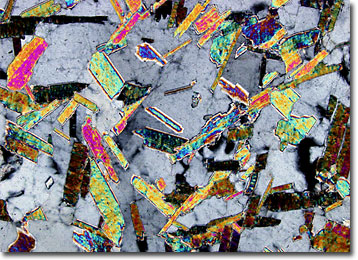Polarized Light Microscopy Digital Image Gallery
Muscovite
Micas are a large group of minerals that are hydrous silicates of aluminum and potassium. Frequently found in the form of scales and sheets, the most common mica is muscovite, which is also alternatively known as potash mica.

View a second image of Muscovite
Typically transparent to translucent, although it may exhibit white, silver, brown, green, or yellow hues, the color of muscovite is dependent upon its iron content. Thin sheets of the mineral, which can be found worldwide, are quite flexible and were formerly used as windowpanes in the Muscovy region of Russia. This usage led to the material being commonly referred to as Muscovy glass, a term which is the origin of the modern name of the mineral. The most prevalent current use of muscovite is as an insulating material, a function it is well suited for due to its low iron content.
Muscovite occurs in metamorphic, igneous, and sedimentary rocks in monoclinic crystals that form diamond-shaped or pseudo-hexagonal “books,” a term which derives from their characteristic appearance. Books of muscovite and other micas can vary drastically in size, some reaching as many as 10 feet in diameter. Also, like other micas, muscovite exhibits perfect cleavage, easily separating into thin, flexible laminae. Other minerals that may be found in association with muscovite include feldspar, quartz, beryl, and tourmaline.
